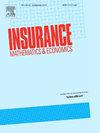一种用于经验评级的观察驱动状态空间计数模型
IF 2.2
2区 经济学
Q2 ECONOMICS
引用次数: 0
摘要
状态空间模型广泛应用于经济学、金融学和精算科学等领域。在计数数据领域,Harvey和Fernandes(1989)提出的模型就是这样一个例子。与许多参数驱动的替代方案不同,该模型是观测驱动的,它导致预测密度的封闭形式表达式。这种预测密度通过分配资历权重来考虑过去的观察结果。这一特性使得该模型对一般保险费率制定非常有吸引力。然而,Harvey and Fernandes(1989)的模型具有方差在长期内发散的性质,这可能是一个不受欢迎的模型特征。在本文中,我们扩展了Harvey和Fernandes(1989)的模型,允许灵活的方差规范,包括非爆炸性的,同时保持模型完全可处理。本文章由计算机程序翻译,如有差异,请以英文原文为准。
An observation-driven state-space count model for experience rating
State-space models are widely used in applications, e.g., in economics, finance and actuarial science. In the domain of count data, one such example is the model proposed by Harvey and Fernandes (1989). Unlike many of its parameter-driven alternatives, this model is observation-driven, and it leads to a closed-form expression for the predictive density. This predictive density takes into account past observations by assigning a seniority weighting to them. This feature makes this model very appealing for general insurance ratemaking. However, the model of Harvey and Fernandes (1989) has the property that the variance diverges in the long-run, which might be an undesirable model feature. In this paper, we extend the model of Harvey and Fernandes (1989) by allowing for flexible variance specifications including non-explosive ones, while keeping the model fully tractable.
求助全文
通过发布文献求助,成功后即可免费获取论文全文。
去求助
来源期刊

Insurance Mathematics & Economics
管理科学-数学跨学科应用
CiteScore
3.40
自引率
15.80%
发文量
90
审稿时长
17.3 weeks
期刊介绍:
Insurance: Mathematics and Economics publishes leading research spanning all fields of actuarial science research. It appears six times per year and is the largest journal in actuarial science research around the world.
Insurance: Mathematics and Economics is an international academic journal that aims to strengthen the communication between individuals and groups who develop and apply research results in actuarial science. The journal feels a particular obligation to facilitate closer cooperation between those who conduct research in insurance mathematics and quantitative insurance economics, and practicing actuaries who are interested in the implementation of the results. To this purpose, Insurance: Mathematics and Economics publishes high-quality articles of broad international interest, concerned with either the theory of insurance mathematics and quantitative insurance economics or the inventive application of it, including empirical or experimental results. Articles that combine several of these aspects are particularly considered.
 求助内容:
求助内容: 应助结果提醒方式:
应助结果提醒方式:


